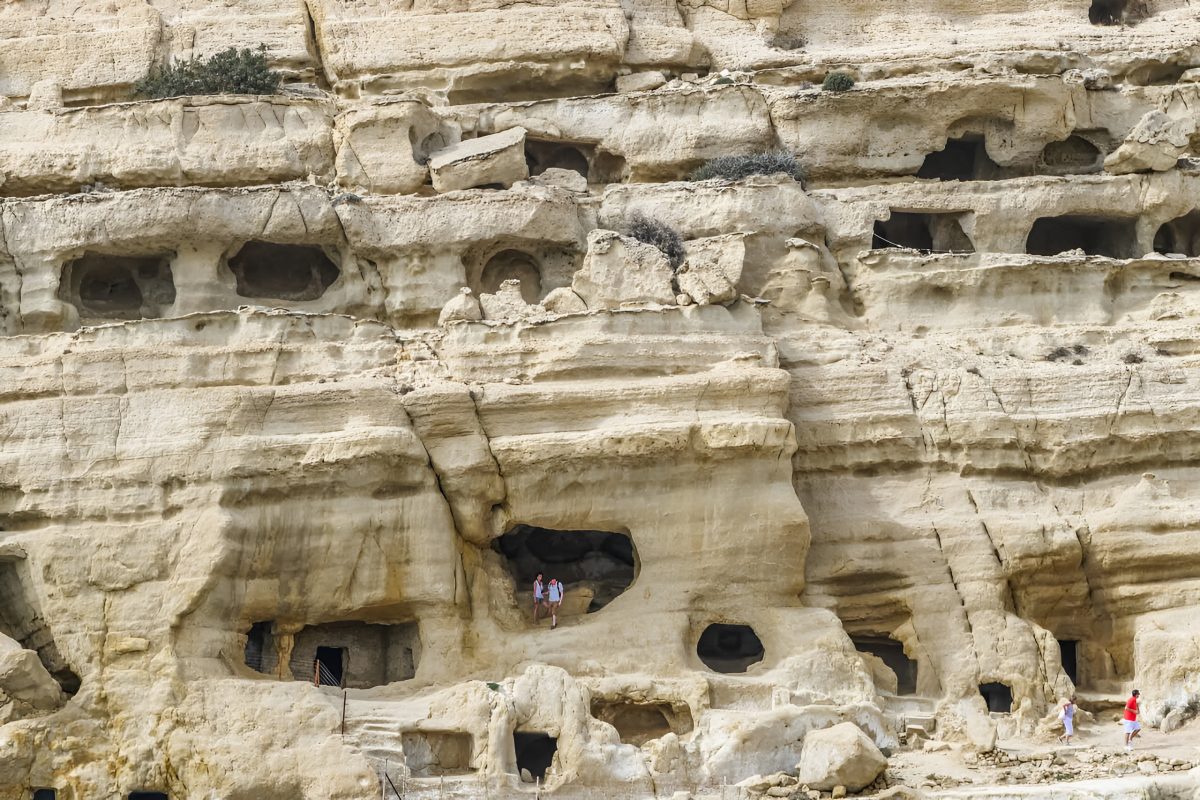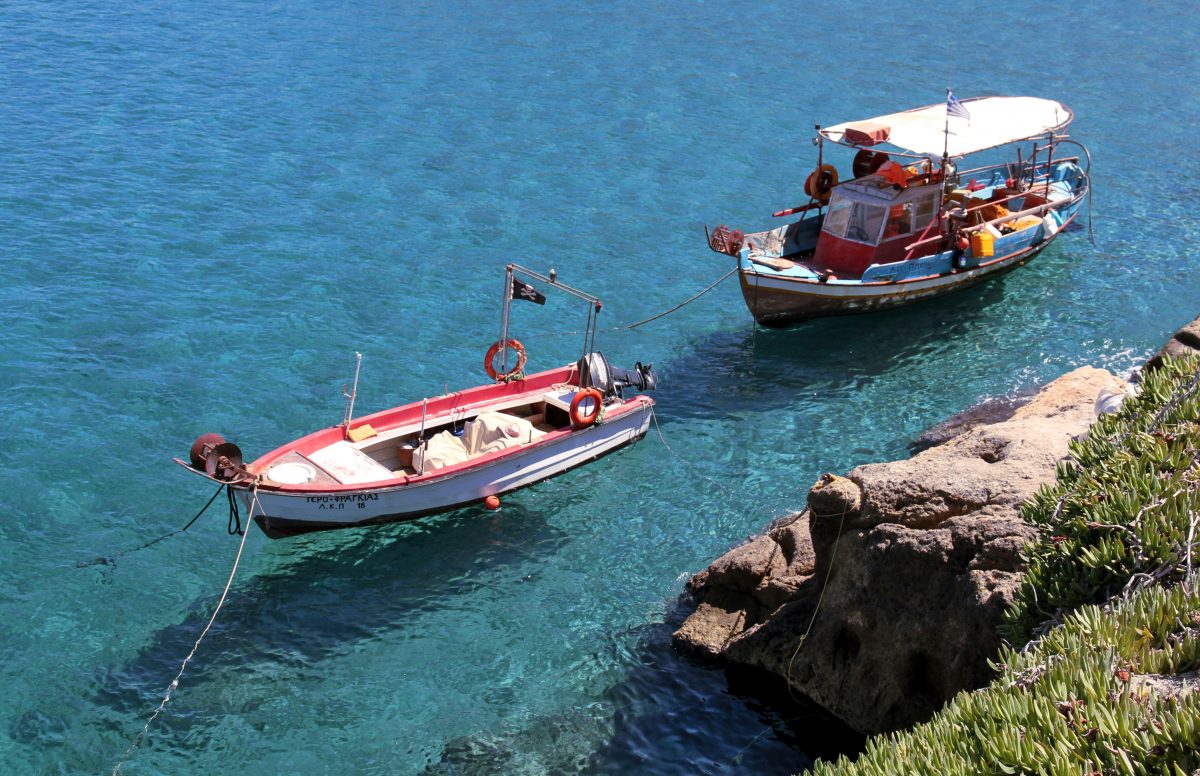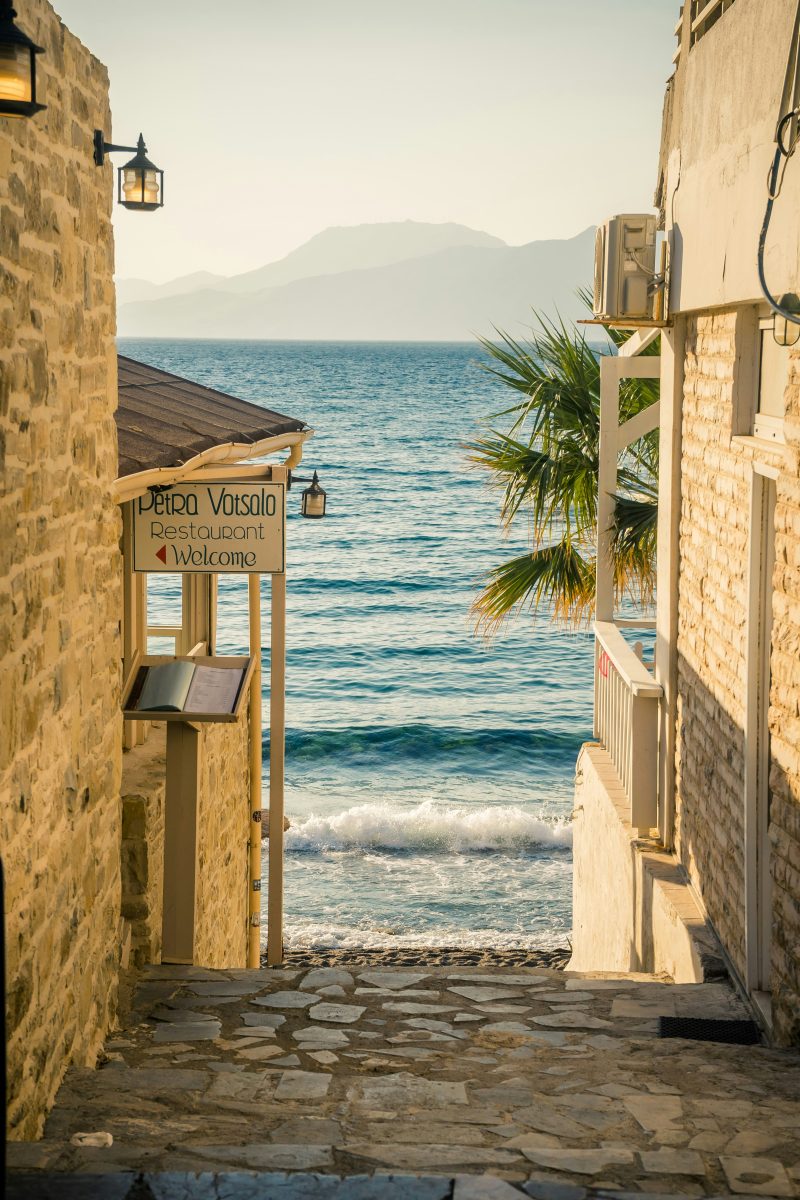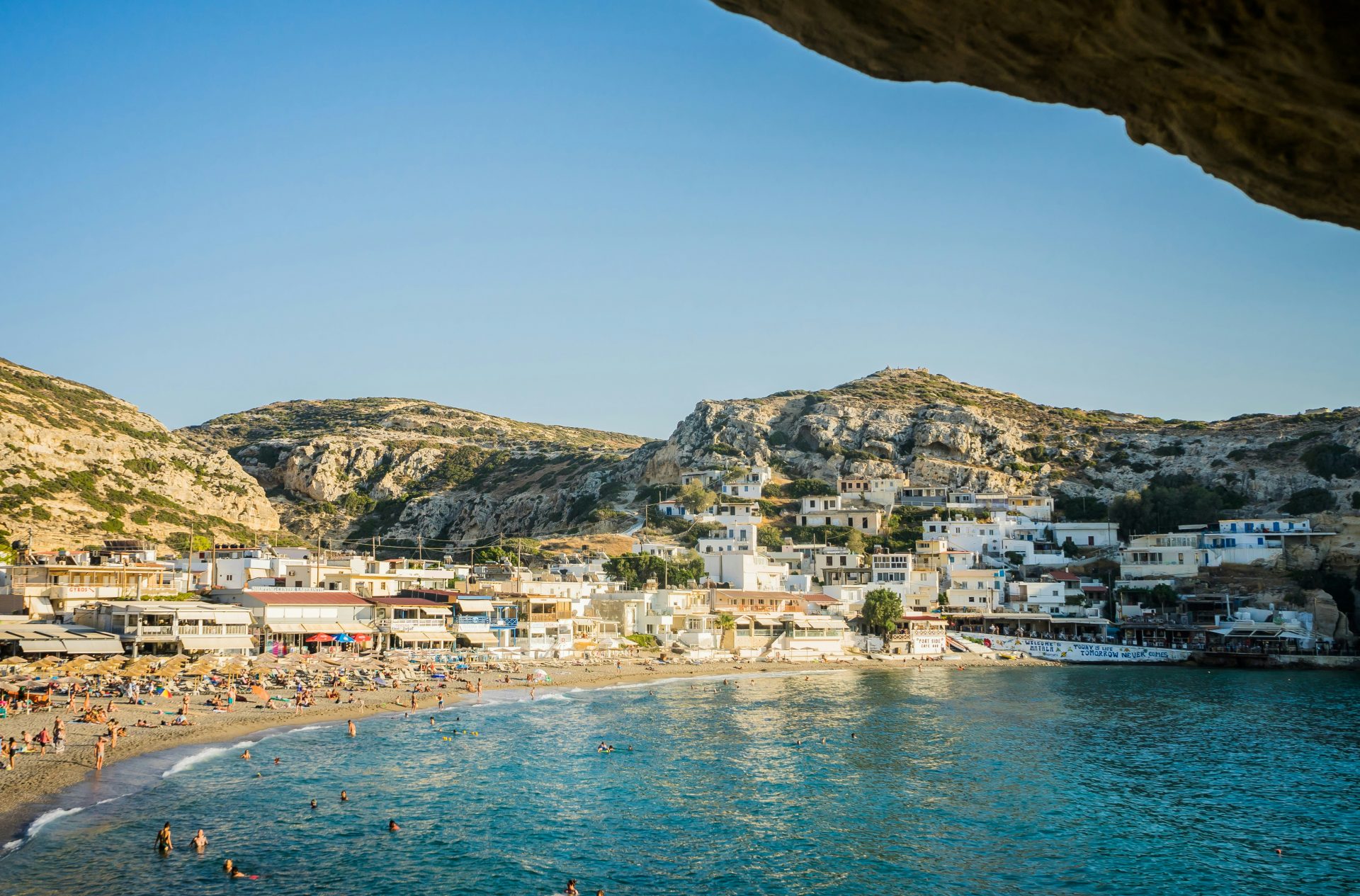Matala Beach is one of the most legendary spots in southern Crete – a 300 m cove backed by sandstone cliffs riddled with caves and a laid-back village atmosphere. Located about 70 km southwest of Heraklion on the island’s south coast, Matala was the ancient port of the Minoan palace of Phaistos and later of Roman Gortyn. According to Greek mythology, Zeus, in the form of a bull, swam ashore here with the princess Europa on his back. In modern times, Matala gained fame during the 1960s as a hippie haven, when nomads and famous musicians camped out in its seaside caves. Today it’s a popular yet unique beach destination – not your typical palm-fringed paradise, but a beautiful cove with crystal-clear blue water, dramatic cliffs, and a nostalgic bohemian vibe that still lingers.
Beachscape and Facilities at Matala Beach
Matala’s beach lies at the exit of a small valley forming a sheltered bay with views of the twin Paximadia islets on the horizon. The shore consists of golden sand mixed with fine pebbles – comfortable enough underfoot. The water is perfectly transparent and a striking blue-green, inviting for swimmers. Keep in mind the bay faces west into the open Libyan Sea, so waves are common in the afternoons when winds pick up. (Many visitors find the morning sea much calmer, with rougher surf later in the day.) The seabed drops off fairly quickly – the water becomes deep just a few meters from shore – so while swimming is lovely, parents should watch young children closely.
Despite its remote feel, Matala is a Blue Flag beach and comes well-equipped for summer visitors. You’ll find sunbeds and umbrellas for hire, lifeguards on duty, public showers, toilets, and even water sports like kayak rentals. A line of open-air tavernas, beach bars, and cafés sits just behind the sand, perfect for a cold drink or a fresh seafood lunch with a view. If you need a break from the sun, seek out the natural shade of tamarisk trees at the back of the beach – a few hardy trees provide dappled shade even on hot afternoons. Matala also has a campground and ample rooms to rent nearby, since many travelers base themselves here in summer. In peak season (July–August) expect the area to be very crowded and lively, with music from the beach bars carrying on into the evenings. The upside of Matala’s popularity is that there’s always a fun, social atmosphere; the downside is that parking can be challenging in high season (arrive early to snag a spot).

The Caves of Matala: Ancient History Carved in Cliffs
One of Matala’s most iconic features is the honeycomb of caves carved into the north cliff bordering the bay. These man-made caves date back thousands of years. Archaeologists believe many were tombs from the Roman and early Christian eras, cut into the soft white limestone rock. Some caves have multiple rooms, stairways and even window openings, suggesting they may also have been used as dwelling places in antiquity. Local legend even nicknames one cave Brutospeliana, claiming the Roman general Brutus once frequented it. There are also several submerged caves under the waterline in the bay – a reminder that this coastline has seen continuous use since Minoan times.
Today the cliff caves are protected as an archaeological site, but you can still visit and explore many of them. A small entrance fee (around €2–€4) is charged at the gate, and the area is generally open to the public from morning until about 5 PM. Inside, you’ll find cavernous chambers where ancient people (and later, 20th-century hippies) once slept. Climbing up to the caves is an adventure in itself: the rock is soft and there are some rough steps, but also loose gravel and no handrails, so use caution and wear good shoes. The higher you scramble, the better the view – from the cave mouths you get a spectacular overlook of the beach and village below. Just remember it’s forbidden to camp or stay overnight in the caves nowadays. In the late afternoon, when golden light hits the cliffs, the caves take on an even more dramatic appearance – it’s easy to see why they’ve captivated visitors for so long.
Hippie Heritage and Local Culture
The iconic slogan “Today is Life – Tomorrow Never Comes” painted on Matala’s waterfront wall harkens back to the village’s hippie era.
Matala’s modern fame truly kicked off in the late 1960s, when the quiet fishing village was “discovered” by hippie travelers looking for a simpler life. Drawn by the empty beach and free shelter of the caves, a community of international “flower children” formed here, living day-to-day by the sea. The hippie enclave at Matala became so popular it attracted counterculture celebrities – singer-songwriter Joni Mitchell lived here briefly in 1970 and later immortalized Matala in songs like “Carey” and “California” on her album Blue. (“They’re playin’ that scratchy rock and roll beneath the Matala Moon,” she sang, referring to evenings in the village.) Other legends like Bob Dylan, Janis Joplin, Joan Baez and Cat Stevens also passed through, enjoying the carefree scene. Back then, Matala had nothing but a few simple tavernas and fishermen’s homes – electricity was scarce, campfires and guitars were common, and the stars and sea were all the entertainment one needed.
The party didn’t last forever. In the early 1970s, during Greece’s military junta, the local church and authorities expelled the hippies, deeming their lifestyle immoral. Many of the evicted free-spirits simply moved on to other remote corners of Crete (some to Preveli and Plakias on the south coast, others to Lendas or Vai, and many onward to the Cycladic island of Ios). Matala fell quiet for a time, and the caves were eventually sealed off for protection. But the spirit of those days was never forgotten. In fact, since 2011 Matala has hosted the “Matala Beach Festival” every June – a three-day summer music festival celebrating peace, love and music, in tribute to the hippie era. During the festival, the village fills with color and nostalgia: live bands (classic rock, reggae, etc.), 1960s-themed art installations, and crowds of all ages reliving the “summer of love.” The festival’s slogan, “Today is Life, Tomorrow Never Comes,” is painted boldly on the seawall (as pictured above) and has become Matala’s unofficial motto. Year-round, you’ll notice vibrant street art of flowers, peace signs and psychedelia in the lanes of Matala, along with shops selling tie-dye shirts and local crafts. There’s even a carved wooden “hippie tree” sculpture in the village center. While Matala today is far more commercial than the sleepy sanctuary of the ’60s, it still embraces its bohemian heritage – visitors are welcomed with a mellow, friendly vibe, and perhaps an invitation to enjoy the same stunning sunset that enchanted those hippie dreamers decades ago.

Getting There and Local Tips
Matala is relatively remote but easy to reach by road. Driving from northern Crete is straightforward – it’s about 1 hour 15 minutes from Heraklion city by car (roughly 70 km) on a paved highway via Mires. From Rethymno, the drive is around 1.5 hours. If you’re coming from the Plakias area (to the west), allow about 1.5–2 hours by car through scenic mountain roads. Parking in Matala is free in designated areas, but as mentioned, in summer those lots fill up fast. Arriving early in the day is wise to secure a spot – by late morning the tour buses and road-trippers arrive. Another option is to take the public bus (KTEL) from Heraklion: buses run several times a day in summer and take about 1.5–2 hours to reach Matala, making stops in nearby villages. This is a convenient and cheap way to visit if you don’t have a car. Organized day tours from major resorts also include Matala on their itineraries.
For enjoying Matala at its best, consider these local tips: Time your visit for early morning or late afternoon if possible. In the morning, you can experience the beach when it’s quieter and the sea is often calm like a pool. By midday, especially in high season, the beach will be teeming with people. Alternatively, staying until sunset is highly recommended – as Matala faces west, it offers a spectacular sunset view with the sun dipping between the cliffs and the sky turning gold and pink. Many people gather on the sand or at cliffside terraces to applaud the sunset. Just note that afternoons can be windy/wavy, so plan your swimming accordingly. If you’re a strong swimmer or snorkeler, you might explore near the northern rocks (some fish and underwater nooks there), but always mind the currents and waves.
Matala can be enjoyed year-round for its scenery and history. In winter it’s quiet and many businesses close, but you can still walk the beach and see the caves from outside. The ideal season is late spring or early fall – May, June or September – when the weather is warm (but not blistering), the sea is swimmable, and crowds are thinner. July and August are the busiest (and hottest) months. The beach officially has lifeguard service and facilities roughly May through October, which coincides with the main tourist season. If visiting in the off-season, bring your own snacks as not all tavernas will be open. One more tip: wear sturdy sandals or shoes if you plan to hike to nearby sites (the rocks can be sharp) and bring a flashlight if you want to peek into the deeper caves. And as with anywhere in Crete, use sunscreen liberally – the south coast sun is strong, especially with the reflective sand and sea.
Hiking to Red Beach (Kokkini Ammos)
If you have time and energy, don’t miss the short hike to Red Beach, one of Matala’s “secret” attractions. Red Beach (Kokkini Ammos in Greek) is a secluded cove just over the headland south of Matala. To reach it, you follow a marked footpath starting at the southern end of Matala Beach – the trail winds up over the hill, offering fantastic views back over Matala along the way. It takes about 25–30 minutes of hiking to arrive at Red Beach. The walk is moderately steep but well-trodden; sturdy shoes and a water bottle are advised in summer.
Despite the name, Red Beach isn’t literally red – the sand has an orange-ochre tone that can appear reddish in certain light (especially at sunset). It’s a lovely, natural beach with coarse sand and clear water, backed by bare hills. Because of its isolation, Red Beach tends to be much quieter than Matala. It’s unofficially a nudist-friendly beach – don’t be surprised if some fellow beachgoers are sunbathing in the buff (toplessness and nudity are common here, though not mandatory). The atmosphere is peaceful and rustic. There are no buildings except perhaps a small makeshift cantina in peak season, so bring any supplies you need. Note that Red Beach is exposed to winds – it can be a bit windy and the sea occasionally choppy, as the cove is more open than Matala’s. Still, it’s a wonderful spot to chill out after the bustle of Matala; many say it feels like a step back in time to Crete’s unspoiled past. The sunset from Red Beach is gorgeous as well, and you’ll often have plenty of space to yourself by late afternoon. Just remember to hike back before dark (or bring a torch) since the trail is rocky.
Other Nearby Attractions
Matala’s central position on the south coast makes it a handy jumping-off point for exploring a wealth of natural and historical sites in the area:
- Kommos Beach: Just 4 km north of Matala (a 5–10 minute drive) lies Kommos, an endless sandy beach that was once the port of ancient Phaistos. Today Kommos is known for its sand dunes, nesting sea turtles, and nudist-friendly sections. The northern end of Kommos beach is an archaeological site where you can see ruins of Minoan harbor structures (fenced off but visible). With its tamarisk trees and lack of buildings, Kommos feels pristine. Note there’s minimal shade and it can be windy with strong currents, so exercise caution when swimming. It’s a great beach for a long walk at sunset. A few tavernas are located at the nearby village of Pitsidia and along the approach road to Kommos, but the beach itself is undeveloped.
- Phaistos Palace: The Minoan Palace of Phaistos (Festos) is a must-see for history enthusiasts, only about 10 km inland from Matala (15 minutes by car). This Bronze Age palace is the second-largest in Crete (after Knossos) and arguably one of the most important archaeological sites on the island. Unlike heavily reconstructed Knossos, Phaistos has been left in a more authentic excavated state, so you can wander the ancient courtyards, storerooms and royal apartments imagining life as it was 3,500 years ago. The famous undeciphered Phaistos Disk was found here. The palace sits on a hill with a stunning panorama of the Messara Plain and Mount Ida – the views alone are worth the trip. Plan on ~1–2 hours at Phaistos; there’s a small entrance fee and a café/shop at the site. (Tip: Go early in the day during summer to avoid the heat, as there is little shade at the ruins.)
- Agiofarago Gorge and Beach: For a true adventure, you can drive ~20 km east to Agiofarago, a secluded gorge that opens to a hidden beach. The drive involves some rough roads past Odigitria Monastery and then a 30-minute hike through a dramatic canyon. At the end, you’re rewarded with a tiny pebble beach enclosed by towering cliffs – a favorite among nature lovers and often very quiet. There are sea caves, goats clambering on the rocks, and an ambience of holy solitude (Agiofarago means “Saint’s Gorge” because hermits once lived in the caves). Bring water/food as there are no facilities. This excursion is off the beaten path and offers a taste of wild Crete.
- Gortyn (Gortys) Ruins: About 30 km northeast of Matala (near the town of Mires) lies ancient Gortyn, which was a prominent Roman city and the capital of Crete in Roman times. The site is spread out amid olive groves. The most famous artifact here is the Gortyn Law Code, inscribed on a large stone wall – Europe’s earliest written law code (5th century BC). You can also see the roofless Basilica of St. Titus, a stone theater, and remains of temples and dwellings. Gortyn isn’t as visually striking as Phaistos, but if you love ancient history it’s worth a stop – especially since it’s so close to Matala’s environs. There’s a small entrance fee, and guides sometimes offer their services at the gate.
Finally, if you’re touring around, consider visiting some traditional villages in the hills above Matala. For example, Kamilari (8 km away) is a charming village with tavernas and a notable Minoan beehive tomb. Or drive up to Zaros, at the foot of the Psiloritis Mountains, known for its freshwater lake and trout farms. These inland villages offer a glimpse of authentic Cretan life beyond the beach.
In short, Matala is not only a destination in itself but also a gateway to the rich sights of south-central Crete – from ancient palaces and lost cities to hidden beaches and scenic gorges, all within an hour’s drive.

Where to Stay: Matala and Beyond
As a beloved beach town, Matala offers plenty of places to stay. There are small family-run hotels, apartment rentals, and a well-known campground just steps from the beach. Staying in Matala village means you can walk to the beach early and even enjoy the atmosphere after the day-trippers leave. However, keep in mind it can be very busy and lively in peak season (great for those who enjoy a bit of nightlife at the beach bars, less ideal if you’re seeking total tranquility). If you prefer somewhere quieter, the village of Pitsidia (about 3 km away) is a peaceful alternative with a few charming guesthouses – close enough to reach Matala easily, but tucked away from the crowds.
Many travelers exploring Crete’s south coast choose to base themselves in a different village and visit Matala on day trips. One popular base is Plakias, a seaside village west of Matala (around a 1.5-hour drive away). Plakias offers a relaxed atmosphere, a long sand beach of its own, and easy access to other south coast highlights like Preveli Palm Beach, Frangokastello, and coastal hiking routes. This is actually where our boutique hotel is located, offering a tranquil retreat in Plakias with modern comforts and local character. By staying in Plakias, you can enjoy a quieter setting and still drive to Matala for a day (or stop by during a south coast road trip), then return to the calm of a smaller beach town in the evenings. Other nearby areas include Agia Galini (northwest of Matala) which has a harbor town charm, or Mires if you prefer an inland town hub – though for most beach-lovers, staying by the sea is part of the magic.
In summary, you have options ranging from immersing yourself in Matala’s scene by overnighting there, to staying in a serene south coast locale and visiting Matala as an easy excursion. Either way, you’ll be able to experience this unique beach and its surroundings. Just remember to book accommodation in advance for July-August, as the best spots do fill up. And if you stay with us in Plakias, we’ll be delighted to share more local tips to make your Matala visit (and overall Crete adventure) truly unforgettable!
General Information for Matala Beach
- Location: Heraklion Prefecture, Central South Crete (Matala village, 75 km south of Heraklion)
- Beach Type: Sandy cove with fine gravel (golden-beige sand; some pebbles).
- Water & Depth: Clear blue-green water, deep offshore (drops off quickly). Rocky patches in seabed, especially toward center.
- Sea Conditions: West-facing bay – generally calm in morning, often wavy in afternoons due to winds. Winter sees rougher seas; summer afternoons moderate waves are common.
- Natural Shade: Yes – tamarisk trees at back of beach provide shade. Cliffside caves offer shade spots later in day.
- Facilities: Organized beach with sunbeds & umbrellas, lifeguard on duty (in season), public showers and toilets, beach volleyball court, kayak/SUP rentals. Many tavernas, cafés and bars directly behind beach; small convenience stores and gift shops in village. Camping site and parking available (limited capacity in peak season).
- Crowds: Highly popular beach – can be very crowded in summer (July–Aug). Shoulder season (May–June, Sept–Oct) is moderate. Off-season is quiet with few visitors.
- Hippie Heritage: Matala’s cliff caves are a protected archaeological site (open 10:00–17:00, small entry fee) – famous for 1960s–70s hippie community that lived here. Annual Matala Beach Festival each June celebrates this legacy with music and art.
- Nearby Attractions: Walking: Red Beach (30 min hike, south) – secluded nudist-friendly cove. Short drives: Kommos Beach (4 km), Phaistos Palace ruins (10 km), Agiofarago Gorge (21 km). Day trips: Gortyn ancient city (30 km), Preveli Palm Beach (1 hour west), Rethymno Old Town (1.5 hours).
- Accessibility: Road access via paved roads; reachable by KTEL bus from Heraklion (direct daily buses in summer). Village and beach area are mostly pedestrian-friendly; note: there is a short walk (5–10 min) from parking lots to the beach. Not fully wheelchair accessible on sand, but viewpoints exist from promenade.
Matala Beach manages to blend natural beauty, deep history, and a touch of retro free-spirited culture in one place. Whether you come for a day or use it as a base to explore Crete’s south, you’ll find something captivating about Matala – be it the allure of its ancient caves, the unforgettable sunset over the sea, or the echoes of music and laughter that seem to linger in the starlit Matala night. “Today is life, tomorrow never comes,” as the old hippie saying goes – so come enjoy the moment in Matala, a truly special slice of Crete!



